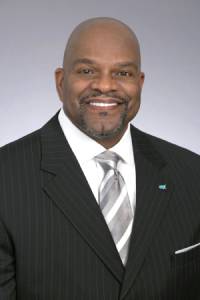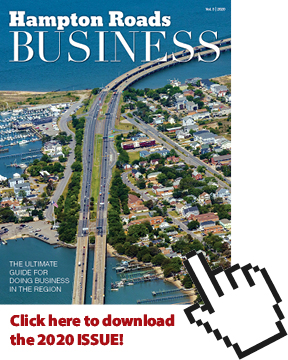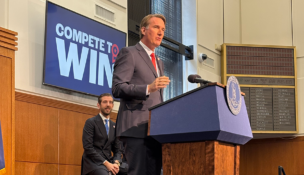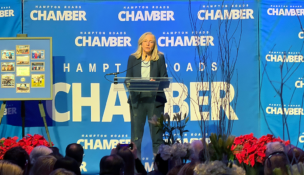Executive Insights
David C. White

Executive vice president, Virginia Maritime Association
What do you consider the most pressing issue facing the Hampton Roads region?
The maritime industry is in the best position to drive the economic growth and job creation for the region. Capacity at the container terminals has been increased to move an additional 1 million containers annually, and dredging is ongoing to make our shipping channels the deepest on the East Coast. These improvements attract businesses involved in international trade and logistics, as evidenced by Amazon’s recent announcement it will build new facilities in Suffolk and Chesapeake, creating 1,500 new well-paying jobs. The U.S. Navy plans to increase and modernize its fleet, and Newport News Shipbuilding has a 10-year backlog of work requiring thousands of new employees. That larger, more modern fleet will require the maintenance capabilities of the companies and workers in our already robust and vital ship repair industry.
Offshore wind development is beginning off the coast of Virginia Beach, Kitty Hawk and elsewhere on the East Coast. Hampton Roads is well-positioned to become the epicenter of these construction and subsequent operations and maintenance activities, resulting in thousands of well-paying new jobs in the 757. The need is for regionwide prioritization and alignment of efforts to develop the supply chains and talent necessary to fully leverage these opportunities.
What changes did you see among VMA member companies due to the COVID-19 pandemic, and how are they doing now?
Our members are largely essential service providers that incurred additional costs to adjust operations and put new safety measures in place to protect employees while they continued to operate, while also experiencing declining volumes and revenues. Fortunately, business for many is bouncing back faster than expected, and forecasts are improving.

Katherine A. Rowe
President, William & Mary
What is William & Mary doing to prepare students for the workforce, and how does a liberal arts curriculum fit into a world increasingly focused on STEM?
Beyond the health and safety of our community, this is the question that keeps me up at night since prior economic downturns have been so hard on rising college graduates. Early in the summer we gathered all staff and administrators doing anything related to career services across the university into a unified Career Pathways Team. They designed an entirely virtual program for the year focused on resilience, adaptability and innovation — calling in alumni, parents and employer partners to support career readiness in this new landscape.
Big picture: A liberal arts and sciences degree is the best preparation for today’s workforce, precisely because we are seeing such rapid change in all industries. The capacities every job requires now are adaptability and range. David Epstein details this in his book “Range”: People who have the capacity to apply their skills flexibly across multiple domains will be most in demand.
The current challenges to create a COVID-19 vaccine offer an example. We need scientists developing the vaccine and, beyond that, we need generalists who can tackle the ethical, economic, logistical and demographic issues that arise once a vaccine is validated and ready for distribution. How do we produce enough [vaccine doses] fast enough and get vaccines to people? Who needs them first? Who is most vulnerable? How do we educate communities to build trust in how vaccines work? With a W&M graduate, you get someone prepared to tackle such complex, multidimensional challenges.
Jennifer Boykin

President, Newport News Shipbuilding
What do you consider the most pressing issue facing the Hampton Roads region?
Businesses, education institutions and the community must share in the responsibility of developing a skilled workforce. That’s why Newport News Shipbuilding has made significant investments in workforce development, education and training initiatives, from our Apprentice School to STEM programs in elementary, middle and high schools.
For the maritime shipbuilding and repair industry, this starts with efforts like the Maritime Industrial Base Ecosystem coalition, which is bringing together industry partners from Hampton Roads and across the commonwealth to examine how we can best prepare to support increasing maritime demands.
What developments are best paving the way for the region’s future?
Looking forward, it’s clear that we can no longer go on with business as usual. The future of Hampton Roads depends on our ability to work together to succeed. I am pleased with continued efforts to promote regional cooperation, and we must continue to break down barriers to find collective solutions to the challenges we all face. This ultimately brings me back to my previous point on workforce development. Our company has a strong track record of partnership with public school systems and community colleges.
On the Peninsula, New Horizons is an asset in providing centralized career and technical education programs for students in seven localities. As we look to increase our collaboration with schools in South Hampton Roads, a similar type of regional cooperation around CTE would benefit students, communities and businesses alike. We owe it to each other to work together to address these pressing regional challenges.

Maurice A. Jones
President and CEO, Local Initiatives Support Corp. (LISC)
How has the pandemic affected LISC’s priorities in terms of supporting underinvested communities?
Between grants and forgivable loans, we will have spent more than $200 million on that kind of assistance. That’s since March! There’s no looking back.
We’ve received about 570,000 applications for small business grants across the country since March. By the end of the year, we will have received a million requests for grants from small businesses.
Our focus has been on businesses that don’t have ongoing relationships with mainstream financial institutions. Over 90% of our grant recipients are businesses led by people of color; 44% of those were African American. Over 85% of businesses we’ve served have been businesses led by women; about 85% have been businesses serving low-wealth communities. Those are the ones most threatened right now.
What developments in Hampton Roads do you consider the most important for the region’s future?
The most promising development I was seeing [before the pandemic] was this budding entrepreneurial ecosystem: incubators, accelerators and angel funders. And the question is, what do COVID and the recession do to that ecosystem? Does it bounce back? Does COVID kill it?
The talent is here, but what [Hampton Roads] needs is more opportunities for that talent to flourish right here. Otherwise, the talent will go to D.C., will go to Richmond, will go to Raleigh. It’s going to take concerted effort from the public and the private sector to help people with small businesses come back. It’s all about resilience.
J.D. Myers II

Senior vice president and region manager of Virginia operations, Cox Communications
What do you consider the most pressing issue facing the Hampton Roads region?
Hampton Roads is one of the most diverse regions in the nation, so let’s move the conversation from “diversity and inclusion” and focus on “equity.” Equity means every employee, regardless of their background, has equal access to growth opportunities. Our C-suites must reflect the communities we serve. And for that to happen, equity must be ingrained in our business cultures.
How has business changed at Cox during the pandemic?
At our core, we’re still the same — innovative and dedicated to doing what’s right. But how we accomplish our work has changed due to COVID-19. For example, we expedited virtual assist and augmented reality tools to support our customers when we couldn’t enter their homes. Additionally, we’re encouraging all our employees who can work from home to continue doing so until January 2021.
Are there any special challenges the Hampton Roads area faces in making sure businesses, schools and households are all able to access reliable internet?
Connectivity is important at any time but during this unprecedented time, it’s everything. Our low-cost internet program, Connect2Compete, is a tremendous resource for families receiving government assistance. For less than $10 a month, students can get internet at home for distance learning. And through June 30, 2021, we’re suspending late fees and extending payment relief options for Connect2Compete customers who express an inability to pay due to pandemic hardships.
>


















